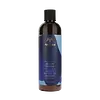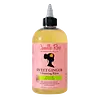What's inside
What's inside
 Key Ingredients
Key Ingredients

 Benefits
Benefits

 Concerns
Concerns

 Ingredients Side-by-side
Ingredients Side-by-side

Water
Skin ConditioningLauramidopropyl Hydroxysultaine
CleansingSodium Cocoyl Isethionate
CleansingCocamide Mipa
EmulsifyingBetaine
HumectantRicinus Communis Seed Oil
MaskingSodium Isethionate
CleansingCetearyl Alcohol
EmollientSodium Chloride
MaskingPiroctone Olamine
PreservativeCeramide NP
Skin ConditioningCeramide EOP
Skin ConditioningCeramide AP
Skin ConditioningPhytosphingosine
Skin ConditioningZanthoxylum Bungeanum Pericarp Extract
Skin ConditioningPhytosterols
Skin ConditioningHydroxypropyl Bislauramide Mea
EmollientHydroxypropyl Bisstearamide Mea
Skin ConditioningMentha Piperita Oil
MaskingMelaleuca Alternifolia Leaf Oil
AntioxidantMenthol
MaskingOlea Europaea Fruit Oil
MaskingPolyglyceryl-10 Laurate
Skin ConditioningGlycol Stearate
EmollientGlyceryl Stearate
EmollientSodium Lauroyl Lactylate
EmulsifyingSodium Cocoyl Glutamate
CleansingCoconut Acid
CleansingGlycerin
HumectantPolyquaternium-7
Stearic Acid
CleansingTrisodium Dicarboxymethyl Alaninate
Hydroxypropyl Cyclodextrin
MaskingCaprylyl Glycol
EmollientEthylhexylglycerin
Skin ConditioningSodium Benzoate
MaskingPotassium Sorbate
PreservativeCitric Acid
BufferingLimonene
PerfumingWater, Lauramidopropyl Hydroxysultaine, Sodium Cocoyl Isethionate, Cocamide Mipa, Betaine, Ricinus Communis Seed Oil, Sodium Isethionate, Cetearyl Alcohol, Sodium Chloride, Piroctone Olamine, Ceramide NP, Ceramide EOP, Ceramide AP, Phytosphingosine, Zanthoxylum Bungeanum Pericarp Extract, Phytosterols, Hydroxypropyl Bislauramide Mea, Hydroxypropyl Bisstearamide Mea, Mentha Piperita Oil, Melaleuca Alternifolia Leaf Oil, Menthol, Olea Europaea Fruit Oil, Polyglyceryl-10 Laurate, Glycol Stearate, Glyceryl Stearate, Sodium Lauroyl Lactylate, Sodium Cocoyl Glutamate, Coconut Acid, Glycerin, Polyquaternium-7, Stearic Acid, Trisodium Dicarboxymethyl Alaninate, Hydroxypropyl Cyclodextrin, Caprylyl Glycol, Ethylhexylglycerin, Sodium Benzoate, Potassium Sorbate, Citric Acid, Limonene
Zingiber Officinale Root Oil
MaskingDisodium Cocoamphodipropionate
CleansingSodium C14-16 Olefin Sulfonate
CleansingCocamidopropyl Betaine
CleansingCitric Acid
BufferingPimpinella Anisum Seed Oil
MaskingRicinus Communis Seed Oil
MaskingPhenoxyethanol
PreservativeEthylhexylglycerin
Skin ConditioningPolyquaternium-10
Sodium Cocoyl Isethionate
CleansingDecyl Glucoside
CleansingGlycol Distearate
EmollientGuar Hydroxypropyltrimonium Chloride
Skin ConditioningZingiber Officinale Root Oil, Disodium Cocoamphodipropionate, Sodium C14-16 Olefin Sulfonate, Cocamidopropyl Betaine, Citric Acid, Pimpinella Anisum Seed Oil, Ricinus Communis Seed Oil, Phenoxyethanol, Ethylhexylglycerin, Polyquaternium-10, Sodium Cocoyl Isethionate, Decyl Glucoside, Glycol Distearate, Guar Hydroxypropyltrimonium Chloride
Ingredients Explained
These ingredients are found in both products.
Ingredients higher up in an ingredient list are typically present in a larger amount.
Citric Acid is an alpha hydroxy acid (AHA) naturally found in citrus fruits like oranges, lemons, and limes.
Like other AHAs, citric acid can exfoliate skin by breaking down the bonds that hold dead skin cells together. This helps reveal smoother and brighter skin underneath.
However, this exfoliating effect only happens at high concentrations (20%) which can be hard to find in cosmetic products.
Due to this, citric acid is usually included in small amounts as a pH adjuster. This helps keep products slightly more acidic and compatible with skin's natural pH.
In skincare formulas, citric acid can:
While it can provide some skin benefits, research shows lactic acid and glycolic acid are generally more effective and less irritating exfoliants.
Most citric acid used in skincare today is made by fermenting sugars (usually from molasses). This synthetic version is identical to the natural citrus form but easier to stabilize and use in formulations.
Read more about some other popular AHA's here:
Learn more about Citric AcidEthylhexylglycerin (we can't pronounce this either) is commonly used as a preservative and skin softener. It is derived from glyceryl.
You might see Ethylhexylglycerin often paired with other preservatives such as phenoxyethanol. Ethylhexylglycerin has been found to increase the effectiveness of these other preservatives.
Ricinus Communis Seed Oil is the INCI name for castor oil.
Castor Oil helps moisturize the skin. It is rich in a fatty acid called ricinoleic acid. This fatty acid helps prevent moisture loss on the skin. This helps keep your skin soft and hydrated. Ricinoleic acid also has anti-inflammatory and pain reducing properties.
Besides hydrating the skin, castor oil is also used to hydrate hair. By keeping the hair shaft moisturized, breakage is decreased. More studies are needed to show castor oil's effective on stimulating hair growth.
Castor oil is created by cold-pressing castor seeds and then purifying the oil with heat. It was used in Ancient Egypt as fuel in lamps and to help treat eye irritation.
The term 'fragrance' is not regulated in many countries. In many cases, it is up to the brand to define this term. For instance, many brands choose to label themselves as "fragrance-free" because they are not using synthetic fragrances. However, their products may still contain ingredients such as essential oils that are considered a fragrance.
Learn more about Ricinus Communis Seed OilSodium cocoyl isethionate is a natural ingredient from coconut oil. It is an ultra gentle cleanser that gives a nice foam without drying the skin or impacting the skin barrier.
The amount of foam created depends on the amount of sodium cocoyl isethionate used in the product.
This ingredient also helps improve the spreadability of a product.
Learn more about Sodium Cocoyl Isethionate